Upcoming Exhibitions
2024 Senior Thesis Exhibition: haven
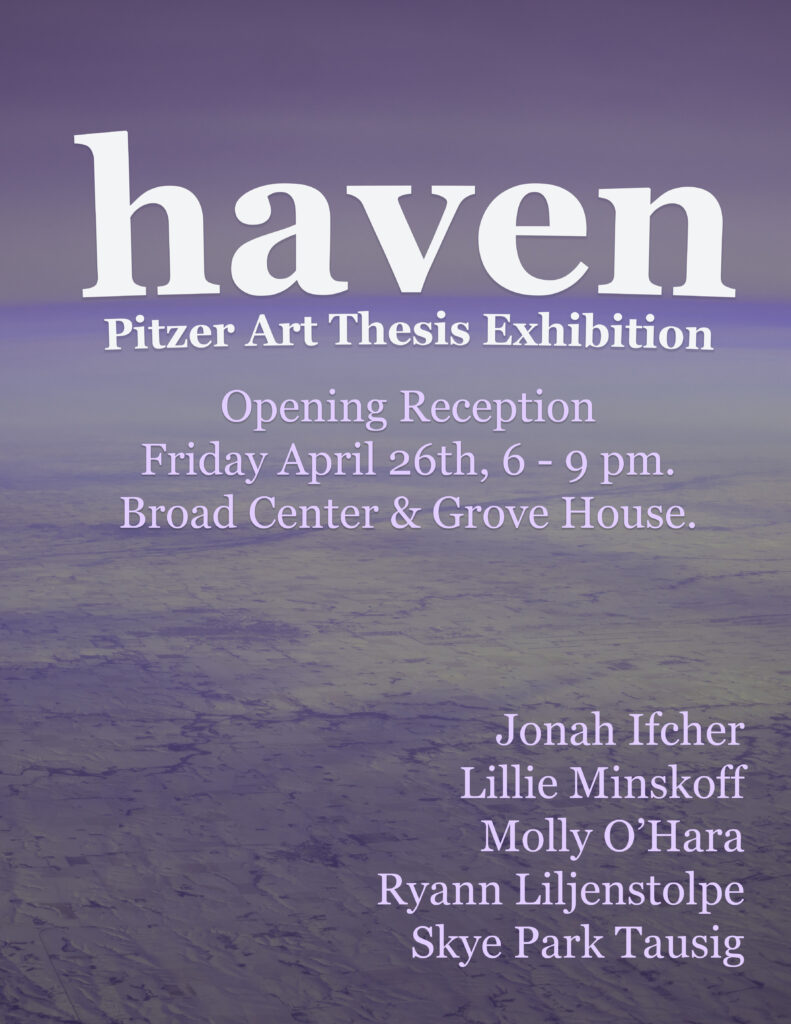
April 26 – May 11, 2024
@Nichols Gallery, Broad Center and Hinshaw Gallery, The Grove House
Jonah Ifcher
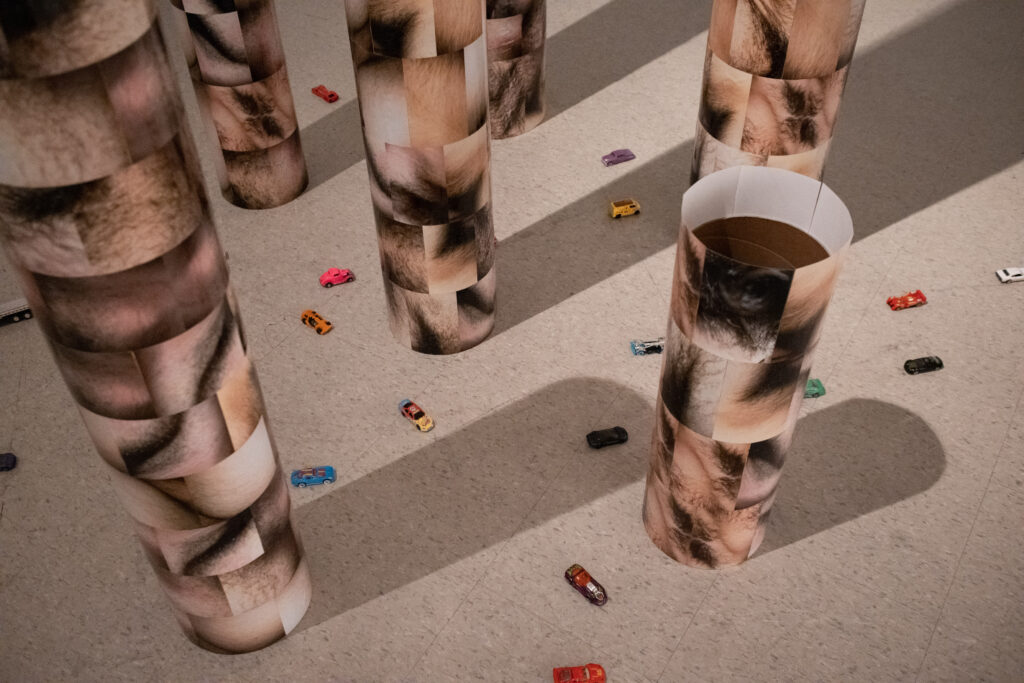
Jonah Ifcher, Sun Room (detail), 2024, cinder blocks, concrete form tubes, c-prints, inkjet prints, and toy cars, dimensions variable.
Jonah Ifcher mines early childhood to construct a fantasy world. This installation, comprising images of his body, toy cars, construction materials, and video, is a playful kaleidoscope of utopia and dystopia, adulthood and youth, safety and peril.
Video work courtesy of Maggie O’Connor.
Lillie Minkskoff
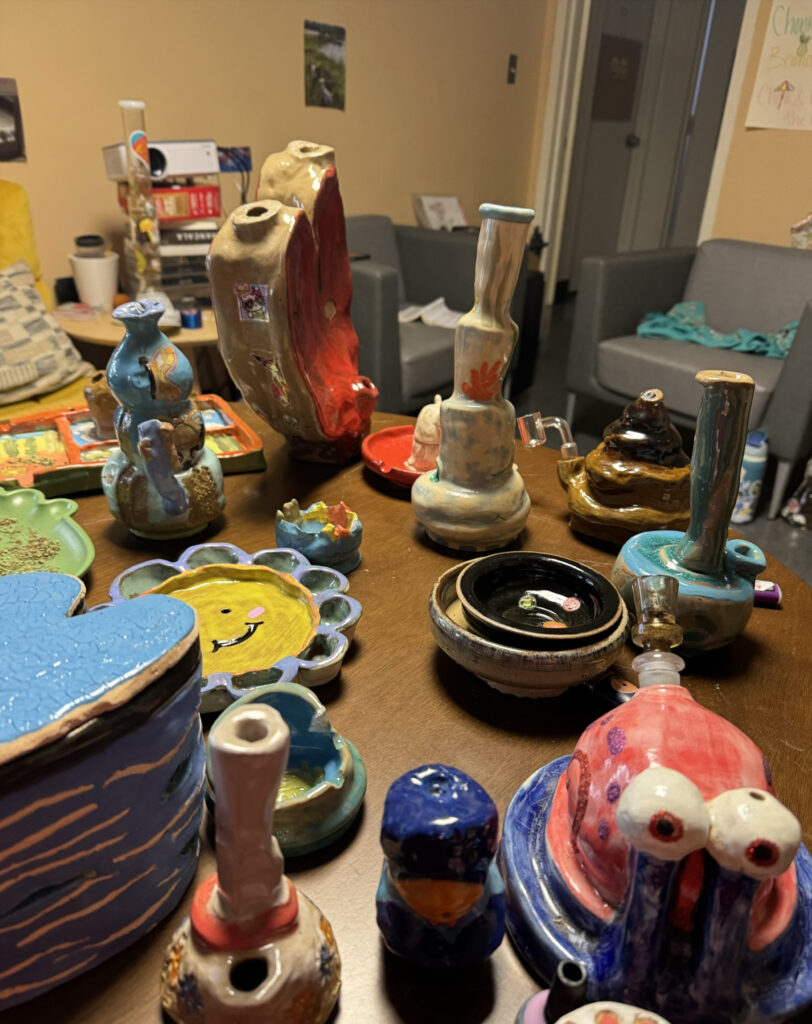
Lillie Minskoff, Potery (detail), 2024, clay, glaze, nail polish, glitter glue, glass, sharpie, stickers, dimensions variable.
Potery is a collection of various functional ceramic pieces for use with cannabis, comprising bongs/water pipes, pipes, ashtrays, rolling trays, storage containers, dab rigs and carb caps. Multimedia artist Lillie Minkskoff hand crafted and painted each highly personalized piece for 15 people of great significance from her time at Pitzer College and the 5Cs. The collection addresses themes of community, comfort, joy, simplicity, whimsy, personal connection, and love. Lillie also emphasizes sentiments of great gratitude and honor for the magical plant that is marijuana. It is key to the collection that viewers and users of the pieces recognize our privilege with the chronic in society today, particularly in California, U.S.A., and even more specifically at Pitzer. A central element that Lillie highlights in Potery is the social power of “the herb,” referring to the plant’s magical ability to bring people together and forge community with like-minded individuals by creating a comforting, relaxing space to simply exist aside one another amidst the chaos of this world. The power of pot helped Lillie make social connections at college, allowing her to come out of her shell, to be vulnerable in unfamiliar environments, to find her second family, whom she loves and cherishes so much and were crucial to her time at Pitzer.
In the exhibition of Potery, Lillie curates a welcoming, peaceful, relaxing environment reflecting the various spaces across the 5Cs in which she has spent much of her time to escape daily challenges and academia, finding solace in the company of friends. The gallery space resembles a living room, with couches, comfy chairs, tables, and lamps. Pictures are scattered across the walls, and eight small shelves are interspersed throughout, displaying select pieces from the collection, while others sit atop the furniture. The environment is meant to be chill and inviting, encouraging and welcoming viewers to engage with the furniture, the pieces, and everything in the room.
A QR code in the gallery connects to a compilation of information about the long, trying history of the magical mary-jane. From curiosity, appreciation, and great religious and cultural significance to prominent “anti-reefer” propaganda throughout history and the journey from criminalization to the legalization within the United States, Lillie unpacks ganja throughout human history in easily digestible, colorful infographics that encapsulate the whimsy of the ceramic collection. Lillie presents viewers with the opportunity to engage comfortably and casually with the realities of all that the plant and its proponents have endured throughout history to fully appreciate and enjoy our privileged contemporary coexistence with cannabis.
Potery is the culmination of all the love and gratitude Lillie has for these people and pot and all the good they’ve brought into her life.
Ryann Liljenstolpe
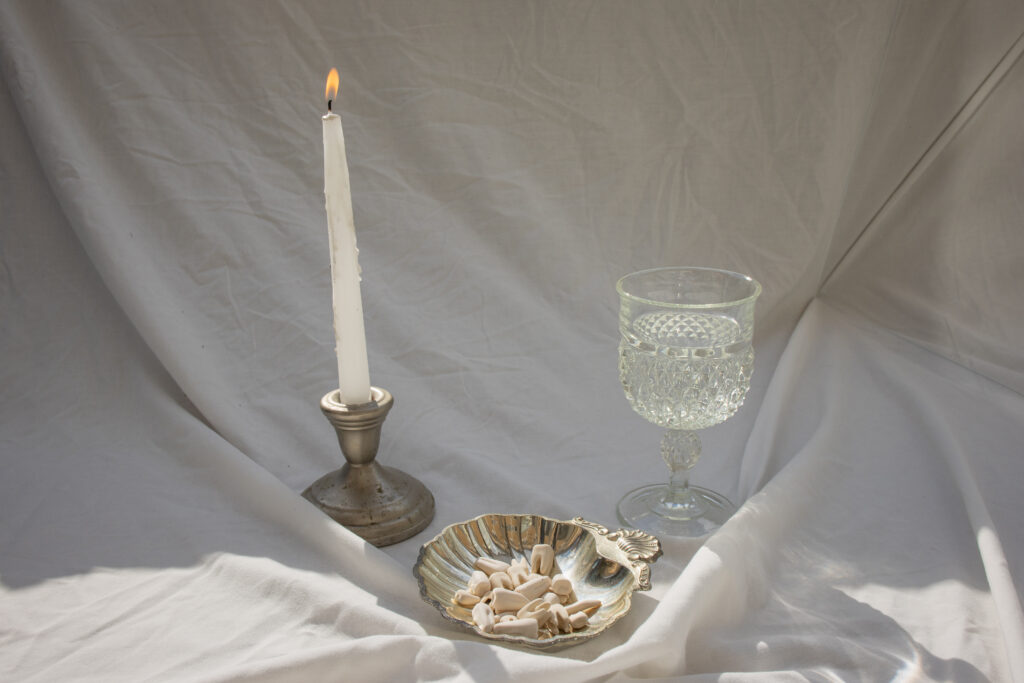
Ryann Liljenstolpe, Furta Sacra (detail), 2024, ceramic, wood, mixed media assemblage including fabric, candles, metal, water, glass, dimensions variable.
Inspired by sacramental rites and holy relics, Furta Sacra emulates a personal altar of the type found in homes across the world. The installation incorporates references to Christian theology and aesthetics in a nod to Liljenstolpe’s sense-memories of religious worship, while also calling attention to social norms of reverence and restraint which are reproduced in museums and galleries. The enclosed space, flickering candlelight, and padded kneeler reflect the setting of an intimate personal sacrament in Liljenstolpe’s imagination, but the installation invites the visitor to concoct a sacrament of their own.
Ryann Liljenstolpe‘s work engages with multisensory immersion through ritual and performance. In their practice, Liljenstolpe makes use of clay, fiber, and mixed media sculptures to explore meaning-making through tactile perception. They employ the less conventional senses in art-viewing—such as touch, smell, and taste—to engage their audience in intimate encounters beyond passive observation. Having spent their formative years in Catholic and Evangelical Christian schools, their current work reflects on a journey of personal liberation and delights in unconstrained expression, invention, curiosity, and institutional critique.
Molly O’Hara
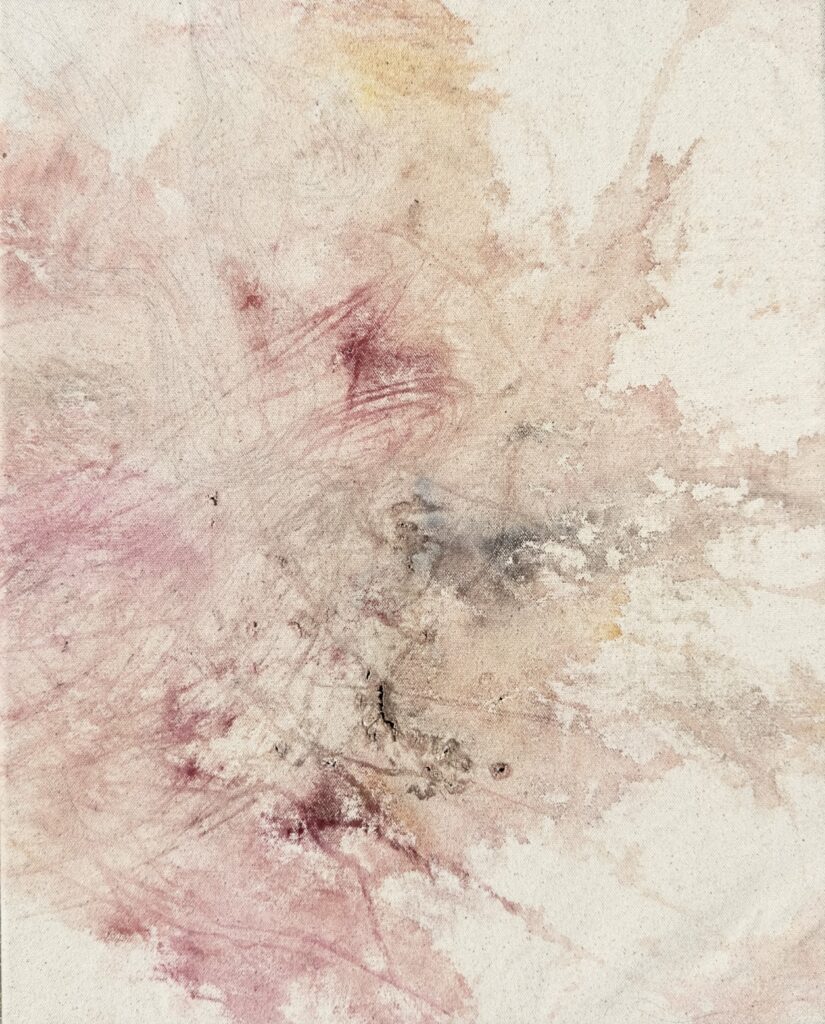
Molly O’Hara‘s paintings delve into the act of self-protection, using the dream catcher as a central motif. These dream catchers, traditionally woven to ward off bad dreams, become metaphors for the strategies we employ to navigate life’s challenges.
O’Hara’s dream catchers appear both literally and symbolically. They evoke the childhood comfort of believing in something magical that safeguards against unseen dangers. However, her paintings move beyond this, acknowledging the very real “nightmares” we face – the loss of a loved one, the sting of betrayal, the anxieties of the future.
These challenges form the core of O’Hara’s exploration. Through childhood drawings, and representations of tissue paper thin memories, she depicts the emotions associated with these hardships – grief, fear, and vulnerability. Yet, interwoven within each canvas are elements that represent her methods of protection. These might be protective talismans, the comfort of nature, or the safety of documented memories.
Ultimately, O’Hara’s paintings are a testament to resilience. They acknowledge the darkness but celebrate the human capacity to build defenses, to find solace, and to rebuild.
Skye Park Tausig
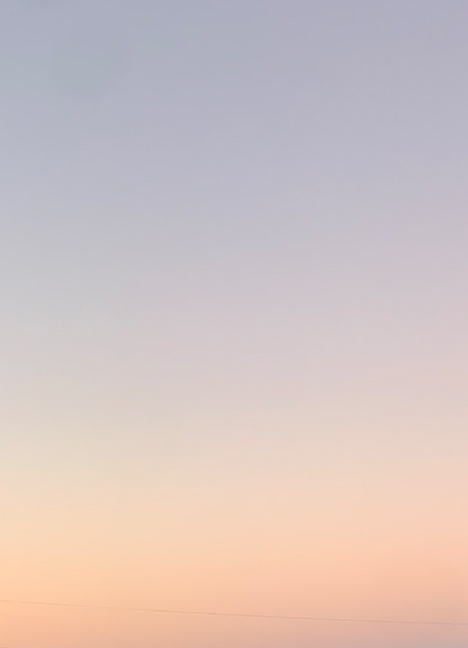
Skye Park Tausig, Quill, Ink, Thorn, 2024, printed books, 5.5 x 8 in. each; concrete powder; cast aluminum; glass; sound.
Quill, Ink, Thorn includes an installation and curatorial book exhibition centered around the layered histories of the Southern California desert. Addressing themes of utopianism, the spectre of desert modernism, and various exploitations of the desert as open space, this two-part exhibition implicates the complex network of actors and agents that function within the endless psychic construction of “the desert.” A storytelling, archival, curatorial, and artistic endeavor, Quill, Ink, Thorn is a conversation about and between those engaged in the construction, transformation, negotiation, and perception of desert spaces.
Skye Park Tausig’s work braids together creative and critical practices with the synergetic aim of making philosophy tactile. Her exhibition work reflects attempts to further her research processes through an exploration of sculptural elements and material contexts. She is fascinated by the inherent co-presence of body and mind, ideology giving rise to object and object containing ideology. Tausig contends that physical, sensory forms of knowing are critical for a deeper understanding of intellectual subjects, and that an art object or piece of design might be understood more thoroughly by the philosophies that it embodies rather than by its form alone.
Reception
Friday, April 26, 2024
6:00 – 9:00 p.m.
Exhibition
April 26 – May 11, 2024
Visit
Hours: Tuesday – Saturday, 12 – 5 pm.
 WORLD IS WATCHING – MANIFESTO
WORLD IS WATCHING – MANIFESTO